Who's Afraid of Beowulf Read online
Table of Contents
Title Page
Copyright Page
Also by Tom Holt
CHAPTER ONE
CHAPTER TWO
CHAPTER THREE
CHAPTER FOUR
CHAPTER FIVE
CHAPTER SIX
CHAPTER SEVEN
CHAPTER EIGHT
CHAPTER NINE
CHAPTER TEN
CHAPTER ELEVEN
CHAPTER TWELVE
www.orbitbooks.net
Copyright
This book is a work of fiction. Names, characters, places, and incidents are the product of the author’s imagination or are used fictitiously. Any resemblance to actual events, locales, or persons, living or dead, is coincidental.
Copyright © 1998 by Tom Holt.
Cover illustration by Joanne Coen. Cover copyright © 2012 by Hachette Book Group, Inc.
All rights reserved. In accordance with the U.S. Copyright Act of 1976, the scanning, uploading, and electronic sharing of any part of this book without the permission of the publisher is unlawful piracy and theft of the author’s intellectual property. If you would like to use material from the book (other than for review purposes), prior written permission must be obtained by contacting the publisher at [email protected]. Thank you for your support of the author’s rights.
Orbit
Hachette Book Group
237 Park Avenue
New York, NY 10017
www.orbitbooks.net
Orbit is an imprint of Hachette Book Group. The Orbit name and logo are trademarks of Little, Brown Book Group Limited.
The publisher is not responsible for websites (or their content) that are not owned by the publisher.
The Hachette Speakers Bureau provides a wide range of authors for speaking events. To find out more, go to www.hachettespeakersbureau.com or call (866) 376-6591.
First US e-book edition: September 2012
ISBN: 978-0-316-23302-6
Also by Tom Holt
Expecting Someone Taller
Who’s Afraid of Beowulf?
Flying Dutch
Ye Gods!
Overtime
Here Comes the Sun
Grailblazers
Faust Among Equals
Odds and Gods
Djinn Rummy
My Hero
Paint Your Dragon
Open Sesame
Wish You Were Here
Only Human
Snow White and the Seven Samurai
Valhalla
Nothing But Blue Skies
Falling Sideways
Little People
The Portable Door
In Your Dreams
Earth, Air, Fire and Custard
You Don’t Have to be Evil to Work Here, But It Helps
Barking
The Better Mousetrap
May Contain Traces of Magic
Blonde Bombshell
Life, Liberty, and the Pursuit of Sausages
Doughnut
CHAPTER ONE
Someone had written ‘godforsaken’ between ‘Welcome to’ and ‘Caithness’ on the road sign. When he saw the emendation, the surveyor almost smiled.
‘Tourists, I expect,’ said the archaeologist disapprovingly. She had decided that the Highlands were authentic and good; therefore, any malice towards them must have proceeded from uncomprehending outsiders.
‘I hope not,’ yawned the surveyor, lighting a cigarette and changing gear. ‘I was taking it as evidence that there’s one native of these parts who can read and write.’ He paused, waiting for a laugh or an ‘I know what you mean’. Neither was forthcoming. ‘Though there’s no reason why any of them should. After all, you don’t need to be able to read if you make your living robbing and killing passing travellers, which has always been the staple industry around here.’
The archaeologist looked away. He was off again. An irritating man, she felt.
‘Which explains the ingrained poverty of the region,’ the surveyor went on remorselessly, ‘because only a few bloody fools ever used to come travelling up here. Until recently, of course. Recently, you’ve had your coachloads of tourists. Theme holidays for heavy sleepers. Anyway, these days the locals don’t even bother killing the travellers; they just sell them tartan key-fobs. And they all take the FT, to keep track of currency fluctuations.’
The archaeologist had had enough of her companion’s diatribe, which had started before the car had got clear of Lairg. Rather ostentatiously she fanned away the cigarette smoke and expressed the opinion that it was all lovely. ‘I think it’s got a sort of—’
The surveyor made a peculiar noise. ‘Listen,’ he said, ‘I was born and bred in bonnie bloody Caithness, and the only thing it’s produced in a thousand years is starving people.’ He’d read that in a Scottish Nationalist manifesto, but it sounded clever. ‘Five years ago, the inhabitants of Rolfsness pleaded with the Water Authority to turn the wretched place into a reservoir so that they could be compensated and move to Glasgow. But it’s too remote even for that. The Army won’t have it for a firing range, and the CEGB got lost trying to find it.’
He was getting nicely into his stride now, despite the lukewarm response. The archaeologist managed to interrupt him just in time.
‘That reminds me,’ she said, tearing her eyes away from a breathtakingly lovely prospect of cloud-topped mountains, ‘I wanted to ask you, since you were born here. Are there any old traditions or folk-tales about Rolfsness?’
‘Folk-tales.’ The surveyor frowned, as if deep in thought. ‘Well, there’s an old superstition among the shepherds and crofters - but you know what they’re like.’
‘Go on.’ The archaeologist felt a tremor of excitement.
‘Well, they say that every year on the anniversary of the battle of Culloden - you know about the battle of Culloden?’
‘Yes, yes, of course.’
‘They say that every year, at about noon, the bus from Wick to Melvich stops here for three minutes where the old gibbet used to be. But nobody’s ever claimed to have seen it for themselves.’
Dead silence. The surveyor shook his head sadly. Americans, he reflected, have no sense of humour.
‘Otherwise, apart from Bonnie Prince Charlie hiding from Butcher Cumberland’s men in what is now the bus shelter, where Montrose had been betrayed to the Covenanters, no. Totally unremarkable place. Now, if there was a story that Montrose wasn’t betrayed to the Covenanters here, that would be a bit out of the ordinary. ’
‘I see.’ The archaeologist sniffed. She should have known better than to ask. ‘So nothing about giants or fairies or the Wee Folk?’
‘Round here,’ said the surveyor grimly, ‘the Wee Folk means Japanese businessmen looking for sites for computer factories. Not that they ever build any, of course. Have you ever tasted Japanese whisky? All the hotels up here sell it now. Personally, I prefer it to the local stuff.’
The archaeologist gave up in despair, and they drove on in silence for a while. Then, as they turned a sharp corner on the side of a towering hill, the archaeologist suddenly asked the surveyor to stop the car.
‘What is it?’ said the surveyor, glancing anxiously in his rear-view mirror, but the archaeologist said nothing. She had no words to spare for such an insensitive person at the moment when she caught her first glimpse of the sea that washes the flat top of the British mainland, and, grey and soft-edged as any dream-kingdom should be, the faint outline of Orkney. On an impulse, she opened the car door and scrambled up to the top of a rocky outcrop.
Here, then, was the earldom of her mind, her true habitation. She felt as Orestes must have done when, coming secretly out of exile, he looked for the first time upon Argos, the
land he had been born to rule. That was the sea of her Cambridge dreams, those were the islands she had first pictured for herself sitting on the front porch in Setauket, Long Island, with her treasured copy of the Orkney-men’s Saga open on her knee. As a promised land it had been to her as she trod the weary road of professional scholarship, laying down her harp beside the waters of Cam, marching more than seven times round the book-shops of St Andrews. As she gazed out over the sea, called ‘whale-road’ and ‘world-serpent’, she could almost see the blue sails of the Orkney Vikings, the dragon-prows of Ragnar Lothbrok and Erik Bloodaxe, sweeping across their great grey highway to give battle to Bothvar Bjarki or Arvarodd in the vik at Tongue.
‘On a clear day,’ said the surveyor behind her, ‘you can just make out the Old Man of Hoy from here. Why you should want to is beyond me entirely.’
‘I think it’s wonderful,’ said the archaeologist softly.
‘I think it’s perishing cold. Can we get on now?’
They got back into the van.
‘Tell me again what it is you’ve found,’ said the archaeologist briskly.
‘Well,’ said the surveyor, leaning back with one hand on the bottom of the steering-wheel, ‘we were taking readings, and I’d just sent the Land-Rover up ahead when it fell clean through this small mound. Right up to its axles, useless bloody thing, we had to use the Transit to pull it out again. Anyway, we got it out and when we looked down the hole it had made we saw this chamber underground, all shored up with pit props. I thought it was an Anderson shelter or something left over from the war, but the lads all said no, ten to one it was a Viking ship-burial. ’
‘They said that?’
‘They all work for the Tourist Board over the summer. So we put a tarpaulin over it and sent for your mob.’
‘Didn’t you want to look for yourselves?’
The surveyor laughed. ‘You must be kidding. Roof might collapse or something. Besides, you aren’t supposed to touch anything, are you, until the experts arrive. Or is that murders?’
The archaeologist smiled. ‘You did right,’ she said.
‘The lads get paid by the hour,’ said the surveyor, ‘and I’m on bonus for being in this wilderness. Besides, if it does turn out to be an ancient monument, the project will be cancelled, and we can all go home with money in lieu. Look, there it is.’
He pulled over on to the verge, and they picked their way over the uneven ground to the site. The archaeologist found that she was faced with a long leaf-shaped mound about fifty to sixty yards long, pointing due north. Under her woolly hat her hairs were beginning to rise, and she broke into a trot, her moon-boots squelching in the saturated peat. The sheer size of it made her heart beat faster. If there really was a ship down there, and if anything at all was left of it, this was going to make the Mary Rose look like a pedalo.
The survey team were staring at her over their cans of lager, but she took no notice. As she struggled with the obdurate ropes that held the tarpaulin in place, an old man in a raincoat apparently moulded on to his body got up hurriedly and started to wave his arms at her. To her joy, the archaeologist realised that he was a Highlander, and that the gist of his broken English was that she was on no account to open up the mound. She beamed at him (for surely this was some survival of the ancestral terror of waking up the sleepers under the howe) and said, ‘Pardon me?’ Her pleasure was somewhat diminished when the surveyor explained to her that what the old fool meant was that he’d spent half the morning nailing the tarpaulin down in the teeth of a gale, and that if she insisted on taking it off she could bloody well put it back herself.
The tarpaulin was thrown back, and the archaeologist nerved herself to look inside and seek her destiny. She had always felt that one day she would make a great discovery, something which would join her with Carnavon, Carter, Evans and Schliemann in the gallery of immortals. On the rare occasions when archaeology had lost its grip on her imagination - seemingly endless afternoons spent up to her knees in mud in some miserable Dartmoor hut-circle - she had consoled herself by trying to compose a deathless line, something which would be remembered beside ‘I have looked upon the face of Agamemnon’. Although so far in her career she had found, apart from enough potsherds to line the bottom of every flowerpot in the world, nothing more prestigious than a Tudor belt-buckle, she knew that one day she, Hildy Frederiksen, would join that select band of immortals who have been fortunate enough to be the first men and women of the modern age to set eyes upon the heirlooms of the human race. She knelt down and with trembling fingers checked the contents of her organiser bag: camera (with film in it), notebook, pencil, small brush, flashlight (free with ten Esso tokens) and small plastic bags for samples.
In the event, what she actually said when the beam of her flashlight licked over the contents of the mound was ‘Jesus!’ but in the circumstances nobody could have blamed her for that. What she saw was the prow of a ship - a long clinker-built ship of a unique and unmistakable kind. The timbers were coal-black and glistening with moisture, but the thing actually seemed to be intact. As the blood pounded in her ears she thanked God for the preservative powers of peat-bog tannin, took a deep breath, and plunged into the hole like a small, learned terrier.
The chamber was intact; so much so, in fact, that the possibility of its collapsing never entered into her mind. The sides were propped with massive beams - oak, at a guess - which vaulted high overhead, while the chamber had been dug a considerable depth into the ground. Under her feet the earth was hard, as if it had been stamped flat into a floor. The ship itself reclined at ease on a stout trestle, as if it was already taking its rightful place in a purpose-built gallery at the maritime museum at Greenwich. It was an indescribably beautiful thing, with the perfection of line and form that only something designed to be functional can have, lean and graceful and infinitely menacing, like a man-eating swan. Every feature she could have hoped to find in an archetypal Viking longship was present - this in itself was remarkable, since none of the ships so far discovered looked anything like the authoritative reconstructions in the Journal of Scandinavian Studies - from the painted shields beside each of the thirty oar-holes on either side of the ship to the great dragon figurehead, carved with a deep confident design of gripping beasts and interwoven snakes. Although it was strictly against the rules, she could not help reaching out, almost but not quite like Adam in the painting, and tracing with the tip of her left forefinger the line of the surrealistic pattern.
Like a child who has woken to find itself inexplicably inside a confectioner’s warehouse, she walked slowly round the great ship, noting the various features of it as if with an inventory. Suddenly the light of her flashlight was thrown back by a sparkle of gold: inlaid runes running back from the prow, glowing bright as neon. She spelt them out, like a child learning its alphabet; Naglfar, the ship of nails, the ferry of the dead. It was so utterly perfect that for a moment she could not bear to look, in case her light fell on an outboard motor bolted to the stern, or a slogan draped across the mast advertising Carlsberg lager.
She touched it again, and the damp sticky feel of the tannin reassured her. Turn the Circus Maximus into a carpark, she said to herself, and wrap fish in the First Folio; preserve only this. As if in a dream, she put her foot on the first rung of a richly carved ladder that rested against the side of the ship.
At the top of the ladder was a small platform, with steps leading down into the hold. She stood for a moment unable to move, for the belly of the ship was piled high with the most extraordinary things, jumbled up together as if History was holding a garage sale. Gold and silver, fabrics, armour and weapons, like the aftermath of an earthquake at a museum. She rubbed her eyes and stared. Under the truncated mast, she could see twelve full sets of armour lying wrapped in fur cloaks, perfectly preserved. No, she was wrong. They were human bodies.
Then the flashlight went out.
The human heart is a volatile thing. A second or so before, Hildy I-Have-Looked-Upon-
The-Face-Of Frederiksen had been thanking Providence that she alone had been granted the privilege of being the first living person in twelve hundred years to set foot on the planks of the longship Naglfar. Now, however, it occurred to her as she stood motionless in the complete silence and utter darkness that it would have been quite nice to have had someone there to share the moment with her, preferably someone with a reliable flashlight. She reminded herself sternly that archaeology is a science, that scientists are creatures of logic and reason, that she was a scientist, therefore she was not in the least afraid of the dark. However, being afraid seemed at that particular moment the most logical thing in the world, the reason why fear circuits had been planted in the human brain in the first place. So deathly was the silence that for a moment she took the sound of her own breathing for the snoring of the twelve dead Vikings lying just a few yards away from her under the mast. She tried to move, but could not; her muscles received the command from her brain and replied that they had never heard anything so absurd in their lives. She reflected that burglars must feel like this all the time, but the thought was little consolation.
As suddenly as it had gone out, the flashlight came back on again - the ways of petrol-station flashlights pass all understanding - and Hildy decided that, although it was really nice inside the chamber, it was probably even nicer outside it. As she turned away towards the ladder, she felt something under her foot and without thinking stooped and picked it up. It felt very cold in her hand, and was heavy, like a pistol. She stopped for a moment and looked at it. In her hand was a golden brooch inlaid with enamel and garnets, in the shape of a flying dragon. She half-expected it to move suddenly, like an injured bird picked up in the garden. The beam of the flashlight danced on interlocking patterns and spirals, and she felt dizzy. She knew perfectly well that she ought not to touch this thing, let alone thrust it deep into her pocket, and equally well that no power on earth could stop her doing it. Then she imagined another noise in the chamber and, with the brooch in her pocket, she scurried down the ladder and out of the mound like a rabbit with a ferret the size of a Tube train after it.

 An Orc on the Wild Side
An Orc on the Wild Side Here Comes the Sun
Here Comes the Sun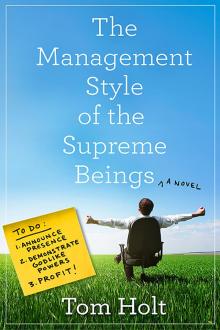 The Management Style of the Supreme Beings
The Management Style of the Supreme Beings May Contain Traces of Magic
May Contain Traces of Magic When It's a Jar
When It's a Jar The Portable Door (1987)
The Portable Door (1987) Odds and Gods
Odds and Gods Earth, Air, Fire and Custard
Earth, Air, Fire and Custard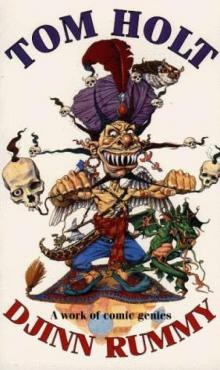 Djinn Rummy
Djinn Rummy Paint Your Dragon
Paint Your Dragon Doughnut
Doughnut The Outsorcerer's Apprentice
The Outsorcerer's Apprentice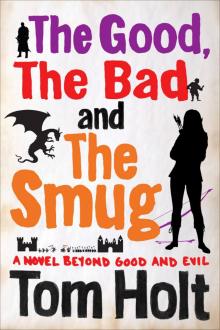 The Good, the Bad and the Smug
The Good, the Bad and the Smug Nothing But Blue Skies
Nothing But Blue Skies Lucia in Wartime
Lucia in Wartime You Don't Have To Be Evil To Work Here, But It Helps
You Don't Have To Be Evil To Work Here, But It Helps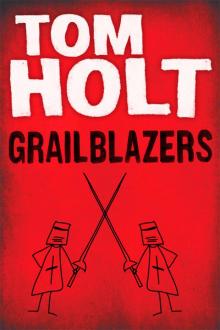 Grailblazers
Grailblazers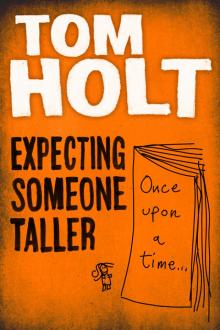 Expecting Someone Taller
Expecting Someone Taller Lucia and the Diplomatic Incident: A Short Story based on the Novels of E.F. Benson (Tom Holt's Mapp and Lucia Series Book 3)
Lucia and the Diplomatic Incident: A Short Story based on the Novels of E.F. Benson (Tom Holt's Mapp and Lucia Series Book 3) Someone Like Me
Someone Like Me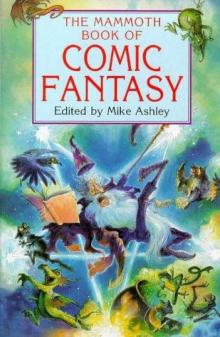 Pizza To Go: The Mammoth Book of Comic Fantasy
Pizza To Go: The Mammoth Book of Comic Fantasy Open Sesame
Open Sesame Who's Afraid of Beowulf
Who's Afraid of Beowulf Faust Among Equals
Faust Among Equals Lucia Triumphant
Lucia Triumphant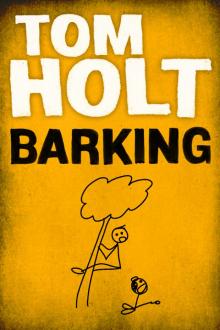 Barking
Barking The Walled Orchard
The Walled Orchard Ye Gods!
Ye Gods!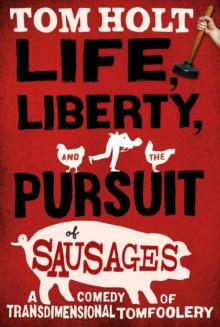 Life, Liberty, and the Pursuit of Sausages
Life, Liberty, and the Pursuit of Sausages Little People
Little People A Song For Nero
A Song For Nero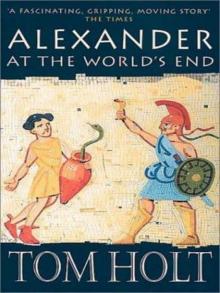 Alexander at the World's End
Alexander at the World's End Flying Dutch
Flying Dutch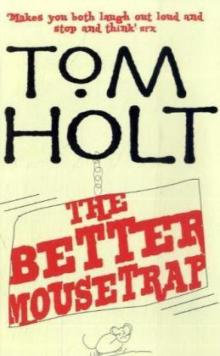 The Better Mousetrap
The Better Mousetrap Falling Sideways
Falling Sideways My Hero
My Hero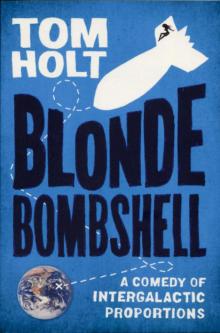 Blonde Bombshell
Blonde Bombshell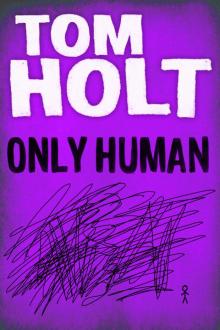 Only Human
Only Human Snow White and the Seven Samurai
Snow White and the Seven Samurai Meadowland
Meadowland